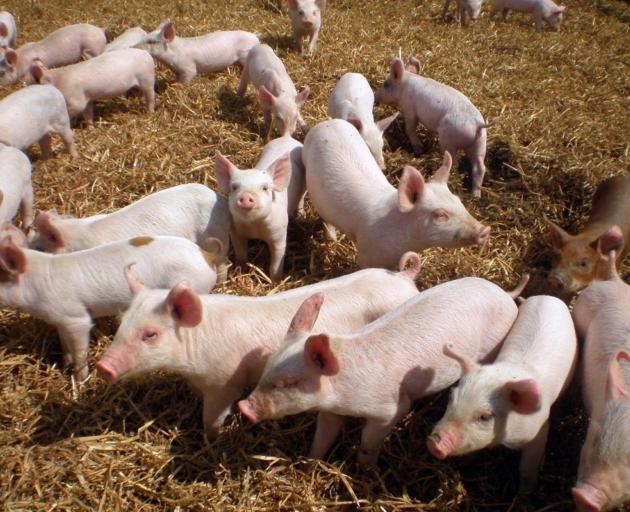
Covid-19 Alert Level 4 and 3 restrictions earlier this year meant independent butchers were not allowed to open fully for retail customers.
That meant a surplus of up to 5000 pigs on New Zealand farms every week and a looming animal welfare issue, the worst-case scenario being the euthanasing of pigs on-farm.
However, such a crisis was averted through various solutions, including an innovative food bank initiative.
During a visit to Dunedin last week, New Zealand Pork chief executive David Baines said that potential surplus — out of a normal 12,000 weekly pig kill — would have been unmanageable.
Solutions included import substitution; 60% of pork consumption in New Zealand came from imported product.
Meat importers were encouraged to keep it in the freezer and use fresh, local product instead.

That came at "quite a severe" cost, wholesalers having to match the price of the cheaper imported pork but it kept the product moving, Mr Baines said.
Another solution was encouraging surplus supply to be cut and frozen, which also generally came at a price penalty.
In May, the Government announced it would buy, at cost price, 40% of the pork surplus and distribute it to New Zealand foodbanks.
National food rescue network KiwiHarvest, in partnership with NZ Pork and the Ministry for Primary Industries, dispatched the meat to community organisations and foodbanks around the country.
It was estimated about 1240 pallets of pork, totalling about 630 metric tonnes, would be delivered during the six-week programme.
Mr Baines said that was a "great solution" which, as well helping solve a problem, put healthy, nutritious food into the hands of people that needed it.
Mr Baines, who began the role in January last year, described it as a "good fit". He had spent most of his career in the domestic meat business, including a strong involvement with pork.
That included setting up Pork Corp, where he was a director and general manager for 20 years, and he had a close association with pig farmers and NZ Pork.
He brought a strong appreciation of the supply chain to the role, which was based at the industry-good body’s head office in Christchurch.
There was a small team and both the board and staff were all relatively new, so there had been somewhat of a fresh approach. Being small meant good connections and communications.
While the industry faced various challenges, there were also plenty of opportunities, Mr Baines said.
One of its big issues at the moment was country-of-origin labelling regulations. Due to the disruption of Covid-10, the Ministry of Business, Innovation and Employment had announced a delay in recommending those regulations. They were supposed to be implemented in May but had been deferred for up to 12 months, he said.
While a portion of the population could not afford to pay more for products, he believed there was a significant segment who, if they knew where a product came from, would choose to support New Zealand products.
NZ Pork had done consumer research and established that consumers wanted clarity around country of origin at the point of purchase. Now, more than ever, the public also wanted to support New Zealand businesses and farmers.
Keen to get the regulations "across the line", he encouraged consumers to seek clarification at stores as to where the pork products were from.
New Zealand’s animal welfare standards were among the highest in the world but no pork coming into New Zealand met those current requirements.
But the industry’s biggest challenge was biosecurity. An outbreak of the highly contagious virus African swine fever had resulted in China losing several hundred million pigs to the disease over recent years and the disease continued to spread.
One positive of the plummet in visitor numbers to New Zealand due to Covid-19 had been the reduction in risk of the disease arriving in the country, he said.
Farmers and the industry were also concerned about the risk of PRRS (porcine reproductive and respiratory syndrome virus); 80% of imports into New Zealand came from PRRS-positive countries, he said.
Another Covid-19-related issue was the effect on migrant workers, whom the pork industry was very reliant on.
It was quite a small workforce in New Zealand, with between about 300 and 400 employed on commercial pig farms, but about 20% of that workforce was migrant labour, so the effect was significant, Mr Baines said.
Many were from the Philippines and had already been trained in the skills required. Not enough people in New Zealand were being trained to gain the skill level needed to fill the gap.
While the Government had announced a six-month visa extension, that was only short-term relief, he said.
New Zealand had about 93 commercial pig farms and pig farming, compared with the production of other forms of protein, had a strong story to tell in terms of its environmental footprint and production efficiencies.
Tools had been developed to measure the environmental footprint of farms, and they showed it was significantly lower on pig farms than on sheep and beef farms.
NZ Pork was embarking on an eating-quality project, partnering with AgResearch, and using the "huge" amount of work Australian Pork Ltd had done on the subject and agreed to make available — validating those findings in the New Zealand context.
When it came to production systems, indoor farming achieved better outcomes in terms of animal welfare and environmental management.
The challenges the industry faced were similar to many of those faced by other farming industries. People did not often understand what was required to operate a business that produced animal protein, and that it could be done responsibly, and that those involved in those farming businesses were strong contributors to society.













